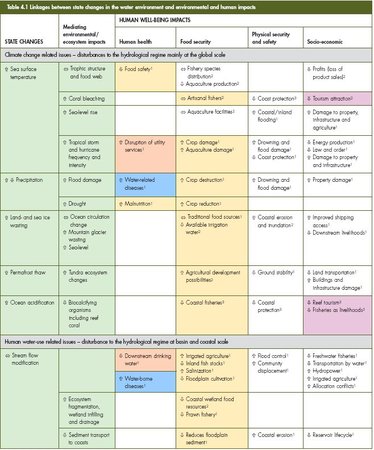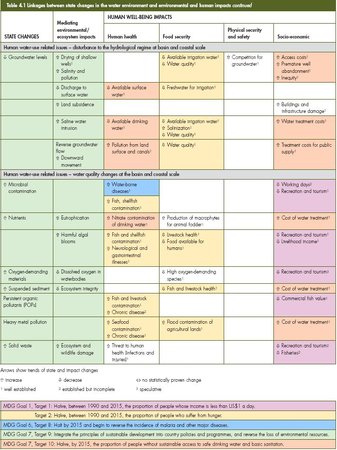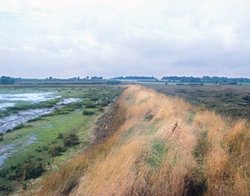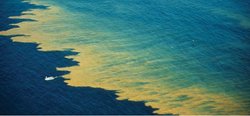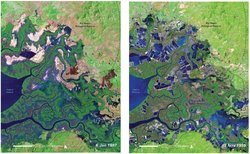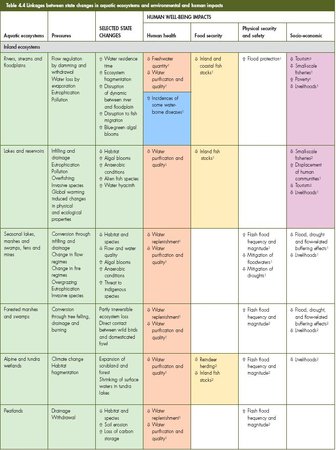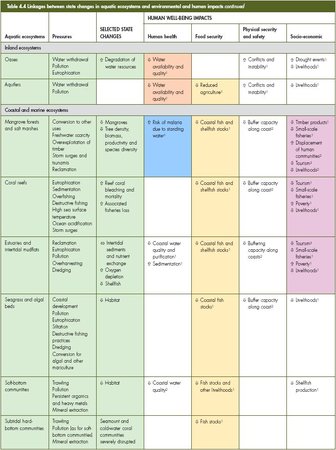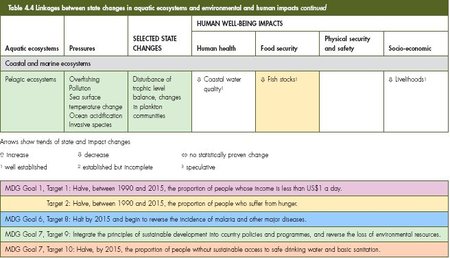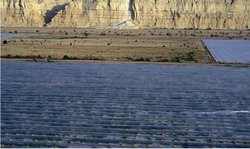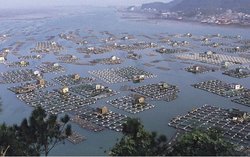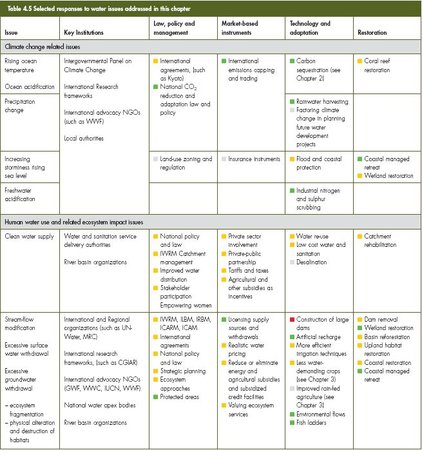Global Environment Outlook (GEO-4): Chapter 4
Contents
- 1 Chapter 4: Water (Global Environment Outlook (GEO-4): Chapter 4)
- 2 Main messages
- 3 Introduction Fig 4.1 Global distribution of world's water.[1] In 1987 the World Commission on Environment and Development (Brundtland Commission) warned in the final report, Our Common Future, that water was being polluted and water supplies were overused in many parts of the world. This chapter assesses the state of the water environment since the mid-1980s, and its impacts on human wellbeing with respect to human health, food security, human security and safety, and livelihoods and socio-economic development. The ocean is the source of most of the world’s precipitation (rainfall and snowfall), but people’s freshwater needs are met almost entirely by precipitation on land (see Figure 4.1), with a small though increasing amount by desalination. Due to changes in the state of the ocean, precipitation (Global distribution of precipitation) patterns (Global Environment Outlook (GEO-4): Chapter 4) are altering, affecting human well-being. Ocean changes are also affecting marine living resources and other socio-economic benefits on which many communities depend. The availability, use and management of freshwater, and of aquatic ecosystems in general, are key to development and human well-being.
- 4 Drivers of Change and Pressures
- 5 Environmental Trends and Responses
- 6 Climate Change Influence
- 7 Water Resources and Use
- 8 Managing water resources and ecosystems
- 9 Fish Stocks
- 10 Challenges and Opportunities
- 11 ContributorsCoordinating lead authors: Russell Arthurton, Sabrina Barker, Walter Rast, and Michael HuberLead authors: Jacqueline Alder, John Chilton, Erica Gaddis, Kevin Pietersen, and Christoph ZöcklerContributing authors: Abdullah Al-Droubi, Mogens Dyhr-Nielsen, Max Finlayson, Matthew Fortnam (GEO fellow), Elizabeth Kirk, Sherry Heileman, Alistair Rieu-Clark, Martin Schäfer (GEO fellow), Maria Snoussi, Lingzis Danling Tang, Rebecca Tharme, Rolando Vadas, and Greg WagnerChapter review editor: Peter AshtonChapter coordinators: Salif Diop, Patrick M’mayi, Joana Akrofi, and Winnie Gaitho (Global Environment Outlook (GEO-4): Chapter 4)
Chapter 4: Water (Global Environment Outlook (GEO-4): Chapter 4)
Main messages
Human well-being and ecosystem health in many places are being seriously affected by changes in the global water cycle, caused largely by human pressures. The following are the main messages of this chapter:
Climate change, human use of water resources and aquatic ecosystems, and overexploitation of fish stocks influence the state of the water environment. This affects human well-being and the implementation of internationally agreed development goals, such as those in the Millennium Declaration. Evidence shows that implementing policy responses to environmental problems enhances human health, socio-economic growth and aquatic environmental sustainability.
The world’s oceans are the primary regulator of global climate, and an important sink for greenhouse gases. At continental, regional and ocean basin scales, the water cycle is being affected by long-term changes in climate, threatening human security. These changes are affecting Arctic temperatures, sea- and land ice, including mountain glaciers. They also affect ocean salinity and acidification, sea levels, precipitation (Global distribution of precipitation) patterns, extreme weather events and possibly the ocean’s circulatory regime. The trend to increasing urbanization and tourism development has considerable impacts on coastal [[ecosystem]s]. The socio-economic consequences of all these changes are potentially immense. Concerted global actions are needed to address the root causes, while local efforts can reduce human vulnerability.
Freshwater availability and use, as well as the conservation of aquatic resources, are key to human well-being. The quantity and quality of surface- and groundwater resources, and life-supporting ecosystem services are being jeopardized by the impacts of population growth (Human population explosion), rural to urban migration, and rising wealth and resource consumption, as well as by climate change. If present trends continue, 1.8 billion people will be living in countries or regions with absolute water scarcity by 2025, and two thirds of the world population could be subject to water stress.
Practical implementation of Integrated Water Resource Management (IWRM) at the basin scale, including consideration of conjunctive groundwater aquifers and downstream coastal areas, is a key response to freshwater scarcity. Because agriculture accounts for more than 70 per cent of global water use, it is a logical target for water savings and demand management efforts. Stakeholders who pay attention to increasing the productivity of rain-fed agriculture and aquaculture, which can contribute to improved food security, are proving to be successful.
Water quality degradation from human activities continues to harm human and ecosystem health. Three million people die from water-borne diseases each year in developing countries, the majority of whom are children under the age of five. Pollutants of primary concern include microbial pathogens and excessive nutrient loads. Water contaminated by microbes remains the greatest single cause of human illness and death on a global scale. High nutrient loads lead to eutrophication of downstream and coastal waters, and loss of beneficial human uses. Pollution from diffuse land sources, particularly agriculture and urban run-off, needs urgent action by governments and the agricultural sector. Pesticide pollution, endocrine-disrupting substances and suspended sediments are also hard to control. There is evidence that IWRM at the basin scale, improved effluent treatment and wetland restoration, accompanied by improved education and public awareness, are effective responses.
Aquatic ecosystems continue to be heavily degraded, putting many ecosystem services at risk, including the sustainability of food supplies and biodiversity. Global marine and freshwater fisheries show large scale declines, caused mostly by persistent overfishing. Freshwater stocks also suffer from habitat degradation and altered thermal regimes related to climate change and water impoundment. Total marine catches are being sustained only by fishing ever further offshore and deeper in the oceans, and progressively lower on the food chain. The trend of fish stock degradation can be reversed when governments, industry and fishing communities work together to reduce excess fishing effort, subsidies and illegal fishing.
A continuing challenge for the management of water resources and aquatic ecosystems is to balance environmental and developmental needs. It requires a sustained combination of technology, legal and institutional frameworks, and, where feasible, market-based approaches. This is particularly true where efforts are designed to share the benefits of water related ecosystem services rather than merely sharing the water resource alone. In addition to capacity building, the challenge is not only to develop new approaches, but also to facilitate the practical, timely and cost-effective implementation of existing international and other agreements, policies and targets, which can provide a basis for cooperation on many levels. Although many coastal environments are benefiting from existing Regional Seas agreements, there is a paucity of international agreements addressing transboundary freshwater (Freshwater biomes) systems, a significant source of potential conflict in the future. A range of perverse subsidies also hampers the development and implementation of effective management measures at many levels. The benefits of tackling well-understood problems, especially those at the basin scale, are likely to be greatest when efforts are coordinated effectively among different levels of society.
Introduction Fig 4.1 Global distribution of world's water.[1] In 1987 the World Commission on Environment and Development (Brundtland Commission) warned in the final report, Our Common Future, that water was being polluted and water supplies were overused in many parts of the world. This chapter assesses the state of the water environment since the mid-1980s, and its impacts on human wellbeing with respect to human health, food security, human security and safety, and livelihoods and socio-economic development. The ocean is the source of most of the world’s precipitation (rainfall and snowfall), but people’s freshwater needs are met almost entirely by precipitation on land (see Figure 4.1), with a small though increasing amount by desalination. Due to changes in the state of the ocean, precipitation (Global distribution of precipitation) patterns (Global Environment Outlook (GEO-4): Chapter 4) are altering, affecting human well-being. Ocean changes are also affecting marine living resources and other socio-economic benefits on which many communities depend. The availability, use and management of freshwater, and of aquatic ecosystems in general, are key to development and human well-being.
Solar energy absorbed by the Earth’s surface, particularly the ocean, drives the circulation of the globe’s water. Most water transfer occurs between ocean and atmosphere (Atmospheric composition and structure) by evaporation and precipitation. Ocean circulation – the global ocean conveyor (see Figure 4.2) – is driven by differences in seawater density, determined by temperature and salt content. Heat moves via warm surface water flows towards the poles, and returns in cooler, deep water towards the equator. The cooler returning water is saltier and denser through evaporation, and, as it sinks, it is replaced by warmer water flowing poleward. This circulation is of enormous significance to the world, carrying carbon dioxide (CO2) to the deep ocean (see Chapter 2 (Global Environment Outlook (GEO-4): Chapter 4)), distributing heat and dissolved matter, and strongly influencing climate regimes and the availability of nutrients to marine life. The 1982–1983 intense El Niño provided the evidence that large-scale fluctuations in ocean and atmosphere circulation are coupled, having profound global climatic impacts[18]. There are concerns that climate change might alter global ocean circulation patterns, possibly reducing the amount of heat that is carried north in the Gulf Stream, warming western Europe and the Arctic (see Chapters 2 and 6 (Global Environment Outlook (GEO-4): Chapter 4)).
The water environment and development are strongly interdependent. The state of the hydrological regime, its water quality and [[ecosystem]s] are major factors contributing to human well-being. These linkages are shown in Tables 4.1 and 4.4, demonstrating the implications of the state of water in meeting the Millennium Development Goals (MDGs). The world’s inland and marine fisheries are a crucial part of aquatic living resources that are vital to human well-being. The chapter assesses how these have responded, and are responding, to the impacts of environmental change. The range of international, regional and national policies and management responses, and indications of their success are summarized in Table 4.5 at the end of the Chapter.
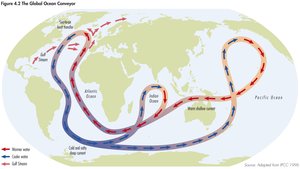 Fig 4.2 The Global Ocean Conveyor.[2]
Fig 4.2 The Global Ocean Conveyor.[2] International water policy is increasingly emphasizing the need to improve governance as it relates to water resources management. A global consensus has emerged on the need to implement ecosystem-based management approaches to address sustainable water resource needs. Through responses such as Integrated Water Resources Management (IWRM), social and economic development goals can be achieved in a manner that gives the world sustainable aquatic ecosystems to meet the water resource needs of future generations. An increasing realization of the limits of traditional regulation has led to the introduction of more participatory regulatory approaches, such as demand management and voluntary agreements. These necessitate education and public involvement.
Drivers of Change and Pressures
The Earth system is modified by natural factors, but human activities have increasingly driven change over the last few decades. The drivers of change in the water environment are largely the same as those influencing change in the atmosphere (Atmospheric composition and structure) and on land (see Chapters 2 and 3 (Global Environment Outlook (GEO-4): Chapter 4)). The world’s population, consumption (Consumption and well-being) and poverty have continued to grow, along with technological advances. Increased human activities are putting pressures on the environment, causing global warming, altering and intensifying freshwater use, destroying and polluting aquatic habitats, and overexploiting aquatic living resources, particularly fish. The modification of the Earth system is taking place both at the global scale, notably through increasing greenhouse gas emissions, leading to climate change, and at the scale of discrete river basins and their associated coastal areas [19].
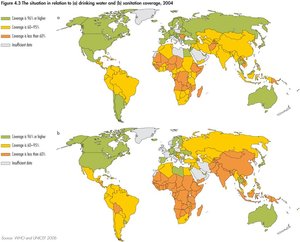 Fig 4.3 The situation in relation to (a) Drinking water and (b) sanitation coverage, 2004.[3]
Fig 4.3 The situation in relation to (a) Drinking water and (b) sanitation coverage, 2004.[3] Human pressures at global to basin scales are substantially modifying the global water cycle, with some major adverse impacts on its interconnected aquatic ecosystems – freshwater (Freshwater biomes) and marine – and therefore on the well-being of people who depend on the services that they provide.
Overexploitation and pollution of water, and degradation of aquatic ecosystems directly affect human well-being. Although the situation has improved (see Figure 4.3), an estimated 2.6 billion people are without improved sanitation facilities. And if the 1990– 2002 trend holds, the world will miss the sanitation target of the Millennium Development Goals by half a billion people [20].
Climate change
Warming of the climate system is unequivocal [21]. Climate change affects the warming and acidification of the global ocean (see [[Chapters 2 and 6 (Global Environment Outlook (GEO-4): Chapter 4)]2]). It influences the Earth’s surface temperature, as well as the amount, timing and intensity of precipitation, including storms and droughts. On land, these changes affect freshwater availability and quality, surface water run-off and groundwater recharge, and the spread of water-borne disease vectors (see [[Chapters 2 and 3 (Global Environment Outlook (GEO-4): Chapter 4)]2]). Some of the most profound climate-driven changes are affecting the cryosphere, where water is in the form of ice. In the Arctic, the increase in temperature is 2.5 times the global average, causing extensive melting of sea and land ice as well as thawing of permafrost [22] (see [[Chapters 2 and 6 (Global Environment Outlook (GEO-4): Chapter 4)]3]). Climate change is expected to exacerbate pressure, directly or indirectly, on all aquatic [[ecosystem]s].
Water use
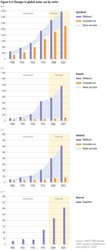 Fig 4.4 Changes in global water use by sector.[4]
Fig 4.4 Changes in global water use by sector.[4] The past 20 years have seen increasing water use for food and energy production to meet the demands of a growing population (Human population explosion) and to enhance human wellbeing, a continuing global trend [23]. However, the changes in the way water is used have significant adverse impacts, which require urgent attention to ensure sustainability. Unlike the pressures of climate change, those of water use are exerted mostly within basins. Some of their drivers are global, but their remedies may be local, though enabled by transboundary conventions.
Current freshwater withdrawals for domestic, industrial and agricultural use, as well as the water evaporated from reservoirs, are shown in Figure 4.4. Agriculture is by far the biggest user. The expansion of hydropower generation and irrigated agriculture, now happening mostly in developing countries, is vital for economic development and food production. But, the consequent changes in land- and water use by agriculture, as well as for urban and industrial growth, have major adverse impacts on freshwater and coastal ecosystems.
In addition to agricultural demands, pressures on water resources are compounded by the physical alteration and destruction of habitats by urban and industrial development, and, especially in coastal areas, tourism. Invasive species, introduced to waterbodies intentionally (fish stocking) or inadvertently (ships’ ballast discharges), are also a factor. Modifications of the water cycle through irrigation works and water supply schemes have benefited society for centuries. However, the global impacts of human interventions in the water cycle, including land cover change, urbanization, industrialization and water resources development, are likely to surpass those of recent or anticipated climate change, at least over decades[24].
Human activities at basin scales cause increased water-borne pollution from point and diffuse sources, affecting inland and coastal aquatic ecosystems. The diffuse sources are more difficult to identify, quantify and manage. Agricultural run-off containing nutrients and agrochemicals is the main source of water pollutants in many countries [25]. Domestic and industrial effluents also are major sources, with inadequately treated wastewater discharged directly into waterways. Virtually all industrial activities generate water pollutants, as do unsustainable forestry (land clearing, forest fires and increased erosion), mining (mine and leachate drainage), waste disposal (landfill leachate, land and sea litter disposal), aquaculture andmariculture (microbes, eutrophication and antibiotics), and hydrocarbon (oil) production and use.
Water withdrawals are predicted to increase by 50 per cent by 2025 in developing countries, and 18 per cent in developed countries [26]. Since nearly all industrial and manufacturing activities require adequate water supplies, this situation is likely to impede socio-economic development, and increase pressures on [[freshwater (Freshwater biomes)] ecosystems]. At the global scale, the integrity of aquatic ecosystems – the state of their physical elements, their biodiversity and their processes – continues to decline [27], reducing their capacity to provide clean freshwater, food and other services such as contaminant attenuation, and to buffer against extreme climatic events. Therefore, changes in the hydrosphere bear heavily on achieving the clean water, health and food security targets of the MDGs.
Fisheries
Several direct pressures contribute to overexploitation of fish stocks, and to the decline of marine mammals and turtles around the world. Population growth and rising wealth have resulted in an almost 50 per cent increase in fish production from 95 million tonnes in 1987 to 141 million tonnes in 2005 [28]. The demand, especially for high-value seafood and to meet population growth, is expected to increase by about 1.5 per cent annually in coming decades. Meeting this demand will be a challenge. For instance, rapid income growth and urbanization in China from the early 1980s to the late 1990s were accompanied by a 12 per cent/year rise in consumption [29]. Another factor is changing food preferences as a result of the marketing of fish in developed countries as part of a healthy diet. Aquaculture continues to grow and, with it, the demand for fish meal and fish oil for use as feed, both of which are derived and primarily available only from wild fish stocks [30]. Fish represent the fastest-growing food commodity traded internationally, causing increasingly serious ecological and management problems [31].
Subsidies, estimated at 20 per cent of the value of the fisheries sector [32], have created excess fishing capacity, which is outstripping available fisheries resources. Global fishing fleets are estimated to have a capacity 250 per cent greater than needed to catch what the ocean can sustainably produce [33]. Furthermore, technological advances have allowed industrial and artisanal fleets to fish with greater precision and efficiency, and further offshore and in deeper water. This affects the spawning and nursery grounds of many species, and decreases the economic possibilities of fishers in developing countries, who are unable to afford such technology [34]. Destructive fishing gear and practices, such as bottom trawlers, dynamite and poison, also compromise the productivity of global fisheries. Trawlers in particular produce by-catch, often consisting of large quantities of non-target species, with an estimated 7.3 million tonnes/year discarded globally [35].
Inland fish stocks are subject to a combination of direct pressures, including habitat alteration, and loss, altered flows and habitat fragmentation due to dams and other infrastructure. They also face pollution, exotic species and overfishing. With much of inland fisheries catches destined for subsistence consumption or local[[market]s], food demand for growing populations is a major factor driving exploitation levels in inland waters.
Superimposed on unsustainable fishing practices and other pressures is global climate change. This may affect aquatic ecosystems in many ways, although the capacity of fish species to adapt to such change is not fully understood. Changes in water temperatures and especially in wind patterns, however, suggest climate change can disturb fisheries, an important emerging issue with potentially serious impacts on global fishery resources.
Environmental Trends and Responses
Human well-being and environmental sustainability are intrinsically interconnected. The state of the global water environment is related to climate change, changes in water use and the exploitation of aquatic living resources, notably fisheries. The consequences of environmental change for human well-being are analyzed in relation to these three issues. Table 4.1 highlights major links between water and human well-being.
Various management responses have been adopted to address the water environment challenges. Although actions that should be taken by individuals and agencies at different levels have been identified, the primary focus is on decision-makers facing water-related challenges. In providing management guidance, the linkages and interactions between the water environment and other components of the global environment (atmosphere (Atmospheric composition and structure), land and biodiversity) must also be considered. For example, the quantity and quality of water resources can determine the types of fisheries that occur. The management options include actions and strategies for prevention, and for mitigation and adaptation (the former seeks to solve the problems and the latter focuses on adjustment to the problems).
Climate Change Influence
Ocean temperature and sea level
At the global scale, ocean temperatures and sea level continue their rising trends. Observations since 1961 show that the average temperature of the global ocean has increased at depths of at least 3,000 metres (m), and that the ocean has been absorbing more than 80 per cent of the heat added to the climate system. Such warming causes seawater to expand, contributing to sea-level rise [36]. The global sea level rose at an average of 1.8 millimeters (m)m/year from 1961 to 2003, and the rate of increase was faster (about 3.1 mm/year) from 1993 to 2003 (see Table 4.2). Whether the faster rate reflects decadal variability or an increase in the longer-term trend is unclear. There is high confidence that the rate of observed sea-level rise increased from the 19th to the 20th century. The total 20th century rise is estimated to be 0.17 m [37].
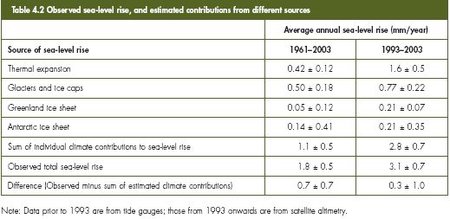 Table 4.2 Observed sea-level rise, and estimated contributions from different sources.[5]
Table 4.2 Observed sea-level rise, and estimated contributions from different sources.[5] Sea surface temperatures and surface currents influence wind patterns in the lower atmosphere, and so determine regional climates. Warming ocean waters and changes in surface currents directly affect marine plant and animal communities, altering fish species distribution and stock abundance. In the tropics, unusually high sea surface water temperatures are becoming increasingly frequent, causing widespread coral bleaching and mortality [38]. There is observational evidence for an increase of intense tropical cyclone activity in the North Atlantic since about 1970, correlated with increases of tropical sea surface temperatures, but there is no clear trend in the annual numbers of tropical cyclones [39] (see [[Chapter 2 (Global Environment Outlook (GEO-4): Chapter 4)]2]).
The warming of the ocean, in particular its surface waters, and the feedback of heat to the atmosphere are changing rainfall patterns, affecting the availability of freshwater and food security, and health. Due to the ocean’s great heat storage capacity and slow circulation, the consequences of its warming for human well-being will be widespread. Both past and future anthropogenic greenhouse gas emissions will continue to contribute to warming and sea-level rise for more than a millennium, due to the timescales required for removal of this gas from the atmosphere [40].
Precipitation
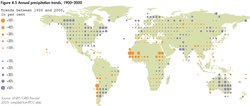 Fig 4.5 Annual precipitation trends, 1900-2000.[6]
Fig 4.5 Annual precipitation trends, 1900-2000.[6] Since at least the 1980s, the average atmospheric water vapour content has increased over land and ocean, and in the upper troposphere. The increase is broadly consistent with the extra water vapour that warmer air can hold [41]. There is increasing evidence that precipitation (Global distribution of precipitation) patterns have changed worldwide as a result of atmospheric responses to climatic change (see Figure 4.5) (see [[Chapter 2 (Global Environment Outlook (GEO-4): Chapter 4)]3]). Significantly increased precipitation has been observed in the eastern parts of North and South America, northern Europe and northern and central Asia [42]. Although precipitation patterns are believed to be increasingly influenced by large-scale warming of ocean and land surfaces, the exact nature of the change is uncertain, though knowledge is improving. Global land precipitation has increased by about 2 per cent since the beginning of the 20th century. While this is statistically significant, it is neither spatially nor temporally uniform. Such spatial and temporal variability is well illustrated in the Sahel region of Africa, which has experienced a succession of comparatively rainy periods alternating with droughts. Following droughts in the 1980s, changes in monsoon dynamics resulted in increased rainfall over the African Sahel and the Indian subcontinent in the 1990s, leading to increased vegetation cover in those areas [43] (see Figure 3.10 – greenness index Sahel).
More intense and longer droughts have been observed over wider areas since the 1970s, particularly in the tropics and subtropics, and drying has been observed in the Sahel, the Mediterranean, southern Africa and parts of southern Asia [44]. The decreasing rainfall and devastating droughts in the Sahel since the 1970s are among the least disputed and largest recent [[climate change]s] recognized by the global climate research community [45] (see Figure 4.5). The reduced rainfall has been attributed to ocean surface temperature changes, particularly to warming of the southern hemisphere oceans and the Indian Ocean, leading to changes in atmospheric circulation [46]. In 2005, the Amazon region suffered one of its worst droughts in 40 years.
For many mid- and high-latitude regions, there has been a 2–4 per cent increase in the frequency of heavy precipitation events over the latter half of the 20th century. An increased frequency and intensity of drought in parts of Asia and Africa was observed over the same period [47]. Increasing variance of continental precipitation is likely, with wet areas becoming wetter and dry areas drier. Recent trends are likely to continue. Increases in the amount of precipitation are very likely in high latitudes, while decreases are likely in most subtropical land regions. It is very likely that heat waves and heavy precipitation events will continue to become more frequent. The frequency of heavy precipitation events has increased over most land areas, consistent with warming and observed increases of atmospheric water vapour [48].
The roles of soil moisture and terrestrial biomes, such as forests, in regulating global water quality and quantity are described in Chapter 3 (Global Environment Outlook (GEO-4): Chapter 4). Depending on local conditions, the effects of irrigation on water vapour flows may be as important as those of deforestation when accounting for the climatic effects of human modification of the land surface that lead to major regional transformations of vapour flow patterns [49].
An increasing frequency and severity of droughts and floods is leading to malnutrition and water-borne diseases, threatening human health and destroying livelihoods. In developing countries, an increase in droughts may lead, by 2080, to a decrease of 11 per cent in land suitable for rain-fed agriculture [50]. The likely increase of torrential rains and local flooding will affect the safety and livelihoods of mostly poor people in developing countries, as their homes and crops will be exposed to these events [51].
Cryosphere
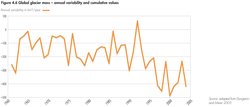 Fig 4.6 Global glacier mass - annual variability and cumulative values.[7]
Fig 4.6 Global glacier mass - annual variability and cumulative values.[7] Continental ice sheets and mountain glaciers have continued to melt and retreat over the last 20 years (see Figure 4.6) (see [[Chapters 2 and 6 (Global Environment Outlook (GEO-4): Chapter 4)]4]). Losses from the ice sheets of Greenland and Antarctica have very likely contributed to global sea-level rise between 1993 and 2003 (see Table 4.2). Flow speed has increased for some Greenland and Antarctic outlet glaciers that drain ice from the interior of the ice sheets [52]. Arctic average temperatures are rising about twice as rapidly as temperatures in the rest of the world, attributed mainly to feedback related to shrinking ice and snow cover [53] (see Chapter 6 (Global Environment Outlook (GEO-4): Chapter 4)). The total Arctic land ice volume, an estimated 3.1 million cubic kilometres {km}, has declined since the 1960s, with increasing quantities of meltwater discharged to the ocean [54]. The Greenland ice sheet has been melting for several decades at a rate greater than that at which new ice is being formed (see [[Chapter 2 (Global Environment Outlook (GEO-4): Chapter 4)]4]). The extent of ice sheet melting was a record high in 2005 [55]. Sea ice cover and thickness have also declined significantly [56] (see [[Chapter 6 (Global Environment Outlook (GEO-4): Chapter 4)]2]).
Permafrost also is thawing at an accelerating rate, with an increase in temperature of 2°C over the last few decades. The maximum area covered by seasonally frozen ground has decreased by about 7 per cent in the northern Hemisphere since 1900, with a decrease in spring of up to 15 per cent [57]. The thawing is causing the drainage of many tundra lakes and wetlands in parts of the Arctic, and is releasing greenhouse gases – especially methane and CO2 – to the atmosphere. The winter freezing period for Arctic rivers is becoming shorter [58] (see [[Chapters 2 and 6 (Global Environment Outlook (GEO-4): Chapter 4)]5]).
The effects of global warming on the state of the cryosphere – increasing permafrost thaw-depth, reducing sea ice cover and accelerating land ice (including mountain glacier) melting – are already having major impacts on human well-being (see [[Chapter 6 (Global Environment Outlook (GEO-4): Chapter 4)]3]). The predicted rise in sea level due to melting land ice will have huge global economic consequences. Over 60 per cent of the global population lives within 100 kilometres of the coastline [59], and sea-level rise is already threatening the security and socio-economic development of communities and cities inhabiting low-lying coastal areas. It affects whole nations comprising small islands, including Small Island Developing States (SIDS). There is likely to be a need for major adaptation, with the relocation of millions of people in coming decades [60] (see Chapter 7 (Global Environment Outlook (GEO-4): Chapter 4)).
While the progressive thawing of permafrost is increasing opportunities for agriculture and the commercial capture of methane gas, it is restricting road transportation, and creating instability in the built environment [61]. It is very likely that the circulation of the North Atlantic will slow down during the 21st Century [62], [63], with possible significant impacts on human well-being in northwestern Europe (see [[Chapter 6 (Global Environment Outlook (GEO-4): Chapter 4)]4]).
Rainwater and ocean acidification
Acidity in rainwater is caused by the dissolution of atmospheric CO2, as well as by atmospheric transport and deposition of nitrogen and sulphur compounds (see [[Chapters 2 and 3 (Global Environment Outlook (GEO-4): Chapter 4)]3]). This is important because biological productivity is closely linked to acidity (see Chapter 3). The box on acidifying cycles in Chapter 3 describes some of the impacts of acid deposition on the world’s forests and lakes.
The oceans have absorbed about half of the global CO2 emissions to the atmosphere over the past 200 years (see [[Chapter 2 (Global Environment Outlook (GEO-4): Chapter 4)]5]), resulting in the increasing [[acidification] of ocean waters] [64]. Acidification will continue, regardless of any immediate reduction in emissions. Additional acidification would take place if proposals to release industrially produced and compressed CO2 at or above the deep sea floor are put into practice [65]. To date, injection of CO2 into seawater has been investigated only in small-scale laboratory experiments and models. Although the effects of increasing CO2 concentration on marine organisms would have ecosystem consequences, no controlled ecosystem experiments have been performed in the deep ocean nor any environmental thresholds identified.
The impacts of ocean acidification are speculative, but could be profound, constraining or even preventing the growth of marine animals such as corals and plankton. They could affect global food security via changes in ocean food webs, and, at the local scale, negatively affect the potential of coral reefs for dive tourism and for protecting coastlines against extreme wave events. It is presently unclear how species and ecosystems will adapt to sustained, elevated CO2 levels [66]. Projections give reductions in average global surface ocean pH (acidity) values of between 0.14 and 0.35 units over the 21st century, adding to the present decrease of 0.1 units since pre-industrial times [67].
Global-scale changes to the water environment associated with climate change include higher sea surface temperatures, disruption of global ocean currents, changes in regional and local precipitation (Global distribution of precipitation) patterns, and ocean acidification. These issues are typically addressed through global efforts, such as the UN Framework Convention on Climate Change and its Kyoto Protocol (see [[Chapter 2 (Global Environment Outlook (GEO-4): Chapter 4)]6]). Management at the global level involves numerous actions at regional, national and local scales. Many global conventions and treaties are implemented on this basis, with their effectiveness depending on the willingness of individual countries to contribute to their achievement. Because these changes are linked to other environmental issues (for example, land use and biodiversity), they must also be addressed by other binding or non-binding treaties and instruments (see Chapter 8 (Global Environment Outlook (GEO-4): Chapter 4)).
Major responses to the drivers of climate change – primarily the increased burning of fossil fuels for energy – are analysed in [[Chapter 2 (Global Environment Outlook (GEO-4): Chapter 4)]7]. These responses are generally at the international level, and require concerted action by governments over the long-term, involving legal and market driven approaches. Focus is on responses to climate change-related impacts affecting the water environment that involve regulation, adaptation and restoration (see Table 4.5 at the end of this Chapter). These actions are implemented mostly at national or even local levels, although usually in accord with regional or international conventions. All such responses should be considered in the context of continuing climate change and its consequences, particularly the longer-term impacts of global sea-level rise on human safety, security and socio-economic development.
Water Resources and Use
Freshwater availability and use
Available water resources continue to decline as a result of excessive withdrawal of both surface- and groundwater, as well as decreased water run-off due to reduced precipitation and increased evaporation attributed to global warming. Already, in many parts of the world, such as West Asia, the Indo-Gangetic Plain in South Asia, the North China Plain and the High Plains in North America, human water use exceeds annual average water replenishment. Use of freshwater for agriculture, industry and energy has increased markedly over the last 50 years (see Figure 4.4).
Freshwater shortage has been assessed as moderate or severe in more than half the regions studied in the Global International Waters Assessment (GIWA) assessment [68]. By 2025, 1.8 billion people will be living in countries or regions with absolute water scarcity, and two-thirds of the world population could be under conditions of water stress, the threshold for meeting the water requirements for agriculture, industry, domestic purposes, energy and the environment [69].
An average of 110 000 cubic kilometeres (km3) of rain falls on the land annually [70]. About one-third of this reaches rivers, lakes and aquifers (blue water), of which only about 12 000 km3 is considered readily available for human use. The remaining two-thirds (green water) forms soil moisture or returns to the atmosphere (Atmospheric composition and structure) as evaporation from wet soil and transpiration by plants [71](see [[Chapter 3 (Global Environment Outlook (GEO-4): Chapter 4)]2]). Changes in land and water use are altering the balance between, and availability of, “blue” and “green” water. They are also exacerbating fragmentation of riverine ecosystems, reducing river flows and lowering groundwater levels. Increasing water loss through evaporation from reservoirs contributes to downstream flow reductions (see Figure 4.4).
Alteration of river systems, especially flow regulation by impoundment, is a global phenomenon of staggering proportions [72]. Sixty per cent of the world’s 227 largest rivers are moderately to greatly fragmented by dams, diversions and canals, with a high rate of dam construction threatening the integrity of the remaining free-flowing rivers in the developing world [73]. Major changes in drainage systems will result from the engineered transfer of water between basins currently being advocated or undertaken in parts of South America, southern Africa, China and India. In southern Africa, water transfers have altered water quality, and introduced new species into the recipient basins. Excessive upstream water use or pollution can have adverse consequences for downstream water demand. In transboundary systems, such as the Nile basin, downstream water uses can threaten the stability of upstream states by constraining their development options. Some large rivers, such as the Colorado (see Box 6.32), Ganges and Nile, are so heavily used that none of their natural run-off reaches the sea [74]. The boundaries of major aquifer systems often do not reflect national borders. The political changes in the former Soviet Union and the Balkans, for example, have greatly increased the number of such transboundary situations [75], and emphasize the need to jointly manage water resources.
|
Box 4.1 Sediment trapping is shortening the useful lifespan of dams[76] |
|
In the Moulouya basin of Morocco, annual rainfall is scarce and concentrated over a few days. Construction of dams has many socio-economic benefits, boosting the economy through agricultural development, improving living standards through hydropower and controlling floodwaters. Because of high rates of natural and human-induced soil erosion, however, the reservoirs are quickly becoming silted. It is estimated the Mohammed V reservoir will be completely filled with sediment by 2030, causing an estimated loss of 70 000 ha of irrigated land and 300 megawatts of electricity. The dams have also modified the hydrological function of the Moulouya coastal wetlands, and caused biodiversity losses, salinization of surface- and groundwater, and beach erosion at the river’s delta, affecting tourism. |
There are more than 45,000 large dams in 140 countries, about two-thirds of these in the developing world [77], with half in China. These dams, with an estimated potential storage volume of 8 400 km3, impound about 14 per cent of global run-off [78]. New dam construction is limited largely to developing regions, particularly Asia. In the Yangtze River basin in China, for example, 105 large dams are planned or under construction [79]. In some developed countries, such as the United States, construction of new large dams has declined in the past 20 years. A few dams have even been decommissioned successfully to benefit humans and nature. In many reservoirs, siltation is a growing problem. Changes in land use, notably deforestation, have led to increased sediment transport through soil erosion and increased run-off. More than 100 billion tonnes of sediment are estimated to have been retained in reservoirs constructed in the past 50 years, shortening the dams’ lifespans, and significantly reducing the flux of sediment to the world’s coasts [80](see Table 4.1).
Reductions in freshwater discharge and seasonal peak flows caused by damming and withdrawal are lowering downstream agricultural yields and fish productivity, and causing the salinization of estuarine land. In Bangladesh, the livelihoods and nutrition of up to 30 million people have declined because ofstream-flow modifications [81]. Over the last two decades, reservoir development in tropical areas, particularly in Africa, has exacerbated water-related diseases, including malaria, yellow fever, guinea worm and schistosomiasis, for example in the Senegal River basin [82]. Reduced sediment discharge to coastal areas is contributing to the vulnerability of low-lying coastal communities to inundation, for example, in Bangladesh. Where reservoir lifespan is being reduced by sediment trapping (see Box 4.1), irrigation schemes and hydropower production will be constrained over the coming decades. Decommissioning silted-up dams may restore sediment fluxes, but is likely to be difficult and costly, and alternative reservoir sites may be difficult to find.
 Table 4.3 Impacts of excessive groundwater withdrawal.[8]
Table 4.3 Impacts of excessive groundwater withdrawal.[8] Severe groundwater depletion, often linked with fuel subsidies, is apparent at aquifer or basin scales in all regions. Excessive groundwater withdrawal, and associated declining water levels and discharges, can have serious human and ecosystem impacts that must be weighed against anticipated socio-economic benefits. Increasing competition for groundwater also can worsen social inequity where deeper, larger capacity boreholes lower regional water levels, increasing water costs, and eliminating access by individuals with shallower wells. This may provoke an expensive and inefficient cycle of well deepening, with the premature loss of financial investment as existing, shallower wells are abandoned. Severe, essentially irreversible effects, such as land subsidence and saline water intrusion, can also occur (see Table 4.3). In the Azraq basin in Jordan, for example, average groundwater withdrawal has risen gradually to 58 million cubic metres(m3)/year, with 35 million m3 used for agriculture and 23 million m3 for drinking water supply. This has decreased the level of the water table by up to 16 m between 1987 and 2005. By 1993, springs and pools in the Azraq Oasis had dried up completely. The reduced groundwater discharge also resulted in increased water salinity [83].
Water quality
Changes in water quality are primarily the result of human activities on land that generate water pollutants, or that alter water availability. Increasing evidence that global climate change can change [[precipitation (Global distribution of precipitation)] patterns], affecting human activities on land and the associated water run-off, suggests global warming also can cause or contribute to degraded water quality. The highest water quality is typically found upstream and in the open oceans, while the most degraded is found downstream and in estuarine and coastal areas. As well as absorbing vast quantities of atmospheric gases as the global climate regulator (see [[Chapter 2 (Global Environment Outlook (GEO-4): Chapter 4)]8]), the ocean’s huge volume provides a buffer against degradation from most water pollutants. This is in contrast to inland freshwater (Freshwater biomes) systems and downstream estuarine and coastal systems. Point and non-point sources of pollution in drainage basins ensure a steady pollutant load into these water systems, highlighting river basin–coastal area linkages.
Human health is the most important issue related to water quality (see Table 4.1). Pollutants of primary concern include microbial contaminants and excessive nutrient loads. Groundwater in parts of Bangladesh and adjacent parts of India has a high natural arsenic content [84], and in many areas fluoride of geological origin produces problematic groundwater concentrations; both have major health impacts. Important point-source pollutants are microbial pathogens, nutrients, oxygen-consuming materials, heavy metals and persistent organic pollutants (POPs). Major non-point-source pollutants are suspended sediments, nutrients, pesticides and oxygen-consuming materials. Although not global-scale problems, highly saline water and radioactive materials may be pollutants in some locations.
Microbial pollution, primarily from inadequate sanitation facilities, improper wastewater disposal and animal waste, is a major cause of human illness and death. The health impacts of wastewater pollution on coastal waters have an economic cost of US$12 billion/year [85]. In at least eight of UNEP’s Regional Seas Programme regions, over 50 per cent of the wastewater discharged into freshwater and coastal areas is untreated, rising to over 80 per cent in five of the regions [86]. This untreated waste has major impacts on aquatic ecosystems and their biodiversity. In some developing countries, only about 10 per cent of domestic wastewater is collected for treatment and recycling, and only about 10 per cent of wastewater treatment plants operate efficiently. The number of people without, or served by inefficient, domestic wastewater treatment systems is likely to grow if investment in wastewater management is not significantly increased [87]. This would make it harder to achieve the MDG target on sanitation (see Figure 4.3).
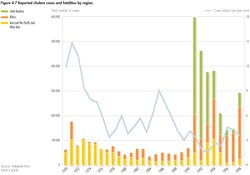 Fig 4.7 Reported cholera cases and fatalities by region.[9]
Fig 4.7 Reported cholera cases and fatalities by region.[9] An estimated 64.4 million Disability Adjusted Life Years (DALYs) are attributed to water-related pathogens [88]. The prevalence of hepatitis A (1.5 million cases), intestinal worms (133 million cases), and schistosomiasis (160 million cases) has been linked to inadequate sanitation. Swimming in wastewater-contaminated coastal waters causes more than 120 million cases of gastrointestinal disease, and 50 million cases of respiratory diseases annually. A strong increase in cholera cases, caused by ingestion of food or water containing the bacterium Vibrio cholerae, was reported between 1987 and 1998 (see Figure 4.7) [89]. It is estimated that in developing countries some 3 million people die of water-related diseases every year, the majority of whom are children under the age of five [90]. The predictions that global warming may change habitats, leading to the spread of water-related disease vectors, poses risks for human health, something that warrants increased concern. The pH of an aquatic ecosystem, a measure of the acidity or alkalinity of water, is important because it is closely linked to biological productivity. Although the tolerance of individual species varies, water of good quality typically has a pH value between 6.5 and 8.5 in most major drainage basins. Significant improvements in pH have been made in parts of the world, likely as a result of global and regional efforts to reduce sulphur emissions [91].
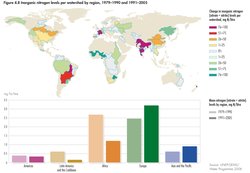 Fig 4.8 Inorganic levels per watershed by region, 1979 - 1990 and 1991 - 2005.[10]
Fig 4.8 Inorganic levels per watershed by region, 1979 - 1990 and 1991 - 2005.[10] The most ubiquitous freshwater quality problem is high concentrations of nutrients (mainly phosphorus and nitrogen) resulting in eutrophication, and significantly affecting human water use. Increasing phosphorus and nitrogen loads to surface- and groundwater come from agricultural run-off, domestic sewage, industrial effluents and atmospheric inputs (fossil fuel burning, bush fires and wind-driven dust). They affect inland and downstream (including estuarine) water systems around the world (see Chapters 3 and 5 (Global Environment Outlook (GEO-4): Chapter 4)). Direct wet and dry atmospheric nutrient inputs are similarly problematic in some waterbodies, such as Lake Victoria [92]. Projected increases in fertilizer use for food production and in wastewater effluents over the next three decades suggest there will be a 10–20 per cent global increase in river nitrogen flows to coastal ecosystems, continuing the trend of an increase of 29 per cent between 1970 and 1995 [93]. Nitrogen concentrations exceeding 5 milligram (mg)/liter (l) indicate pollution from such sources as human and/or animal wastes, and fertilizer runoff due to poor agricultural practices. This results in aquatic ecosystem degradation, with adverse effects on ecosystem services and human well-being (see Figure 4.8 and Table 4.4).
|
Box 4.2 Increasing frequency and area of harmful algal blooms (HABs) in the East China Sea |
 Fig 4.9 Algal blooms in East China Sea.[11] Fig 4.9 Algal blooms in East China Sea.[11] In the East China Sea, the number of harmful algal blooms increased from 10 in 1993 to 86 in 2003, when they covered an area of 13 000 square kilometres. Fertilizer application in the sea’s catchment area has increased by as much as 250 per cent, notably in the upstream and coastal provinces of Anhui and Jiangsu, contributing a high nutrient load to the sea. The blooms, which mostly occur in the inner shelf of the Yangtze River, have a range of human wellbeing and ecosystem implications. High mortality rates of fish and benthic organisms have also been observed. |
Nutrient pollution from municipal wastewater treatment plants, and from agricultural and urban non-point source run-off remains a major global problem, with many health implications. Harmful algal blooms, attributed partly to nutrient loads, have increased in freshwater (Freshwater biomes) and Coastal Systems over the last 20 years (see Figure 4.9 in Box). The algal toxins are concentrated by filter-feeding bivalves, fish and other marine organisms, and they can cause fish and shellfish poisoning or paralysis. Cyanobacterial toxins can also cause acute poisoning, skin irritation and gastrointestinal illnesses in humans. Global warming may be exacerbating this situation, in view of the competitive advantage of cyanobacteria over green algae at higher temperatures.
Organic materials, from such sources as algal blooms and discharges from domestic wastewater treatment plants and food-processing operations, are decomposed by oxygen-consuming microbes in waterbodies. This pollution is typically measured as the biochemical oxygen demand (BOD). High BOD levels can cause oxygen depletion, jeopardizing fish and other aquatic species. Lake Erie’s oxygen depleted bottom zone, for example, has expanded since 1998, with negative environmental impacts. Some coastal areas also undergo oxygen depletion, including the eastern and southern coasts of North America, southern coasts of China and Japan, and large areas around Europe [94]. Oxygen depletion in the Gulf of Mexico has created a huge “dead zone,” with major negative impacts on biodiversity and fisheries [95] (see [[Chapter 6 (Global Environment Outlook (GEO-4): Chapter 4)]5]).
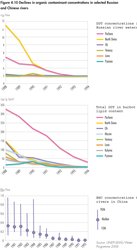 Fig 4.10 declines in organic contaminant concentrations in selected Russian and Chinese rivers.[12]
Fig 4.10 declines in organic contaminant concentrations in selected Russian and Chinese rivers.[12] Persistent organic pollutants (POPs) are synthetic organic chemicals that have wide-ranging human and environmental impacts (see Chapters 2, 3 and 6 (Global Environment Outlook (GEO-4): Chapter 4)). In the late 1970s, studies of the North American Great Lakes highlighted the existence of older, obsolete chlorinated pesticides (so-called legacy chemicals) in sediments and fish [96]. As regulations curtailing their use were implemented, chemical levels have declined in some water systems since the early 1980s (see [[Chapter 6 (Global Environment Outlook (GEO-4): Chapter 4)]6]) (see Box 6.28). Similar declines have since been observed in China and the Russian Federation (see Figure 4.10). The estimated production of hazardous organic chemical-based pollutants in the United States by industry alone is more than 36 billion kilogrammes/year, with about 90 per cent of these chemicals not being disposed of in an environmentally responsible manner [97].
The chemicals in pesticides can also contaminate drinking water through agricultural run-off. There is growing concern about the potential impacts on aquatic [[ecosystem]s] of personal-care products and pharmaceuticals such as birth-control residues, painkillers and antibiotics. Little is known about their long-term impacts on human or ecosystem health, although some may be endocrine disruptors.
Some heavy metals in water and sediments accumulate in the tissues of humans and other organisms. Arsenic, mercury and lead in drinking water, fish and some crops consumed by humans have caused increased rates of chronic diseases. Marine monitoring conducted since the early 1990s in Europe indicates decreasing cadmium, mercury and lead concentrations in mussels and fish from both the northeast Atlantic Ocean and Mediterranean Sea. Most North Sea states achieved the 70 per cent reduction target for these metals, except for copper, and tributyltin [98]. Although occurring in some inland locations, such as the Upper Amazon, oil pollution remains primarily a marine problem, with major impacts on seabirds and other marine life, and on aesthetic quality. With reduced oil inputs from marine transportation, and with vessel operation and design improvements, estimated oil inputs into the marine environment are declining [99] (see Figure 4.11), although in the ROPME Sea Area about 270,000 tonnes of oil are still spilled annually in ballast water. The total oil load to the ocean includes 3 per cent from accidental spills from oil platforms, and 13 per cent from oil transportation spills [100].
Despite international efforts, solid waste and litter problems continue to worsen in both freshwater (Freshwater biomes) and marine systems, as a result of inappropriate disposal of non- or slowly degradable materials from land-based and marine sources [101].
Ecosystem integrity
Since 1987, many coastal and marine ecosystems and most freshwater ecosystems have continued to be heavily degraded, with many completely lost, some irreversibly [102], [103] (see Box 4.3). It has been projected that many coral reefs will disappear by 2040 because of rising seawater temperatures [104]. Freshwater and marine species are declining more rapidly than those of other ecosystems (see Figure 5.2d). Wetlands, as defined by the Ramsar Convention, cover 9–13 million square kilometeres (km2) globally, but more than 50 per cent of inland waters (excluding lakes and rivers) have been lost in parts of North America, Europe, and Australia [105]. Although data limitations preclude an accurate assessment of global wetland losses, there are many well documented examples of dramatic degradation or loss of individual wetlands. The surface area of the Mesopotamian marshes, for example, decreased from 15,000–20,000 km2 in the 1950s to less than 400 km2 around the year 2000 because of excessive water withdrawals, damming and industrial development [106] but is now recovering (see Figure 4.12). In Bangladesh, more than 50 per cent of mangroves and coastal mudflats outside the protected Sunderbans have been converted or degraded.
Reclamation of inland and coastal water systems has caused the loss of many coastal and floodplain ecosystems and their services. Wetland losses have changed flow regimes, increased flooding in some places, and reduced wildlife habitat. For centuries, coastal reclamation practice has been to reclaim as much land from the sea as possible. However, a major shift in management practice has seen the introduction of managed retreat for the marshy coastlines of Western Europe and the United States.
Although limited in area compared to marine and terrestrial ecosystems, many freshwater wetlands are relatively species-rich, supporting a disproportionately large number of species of certain faunal groups. However, populations of freshwater vertebrate species suffered an average decline of almost 50 per cent between 1987 and 2003, remarkably more dramatic than for terrestrial or marine species over the same time scale [107]. Although freshwater invertebrates are less well assessed, the few available data suggest an even more dramatic decline, with possibly more than 50 per cent being threatened [108]. The continuing loss and degradation of freshwater and coastal habitats is likely to affect aquatic biodiversity more strongly, as these habitats, compared to many terrestrial ecosystems, are disproportionately species-rich and productive, and also disproportionately imperiled.
The introduction of invasive alien species, via ship ballast water, aquaculture or other sources, has disrupted biological communities in many coastal and marine aquatic ecosystems. Many inland ecosystems have also suffered from invasive plants and animals. Some lakes, reservoirs and waterways are covered by invasive weeds, while invasive fish and invertebrates have severely affected many inland fisheries.
Declines in global marine and freshwater fisheries are dramatic examples of large-scale ecosystem degradation related to persistent overfishing, pollution, and habitat disturbance and losses. Although there are limited data, marine fish stock losses and declines in marine trophic levels suggest large areas of marine shelf areas have been degraded by trawling over the last few decades. While most deep-sea communities are likely to remain relatively pristine, seamount and cold-water coral communities in the deep sea are being severely disrupted by trawling, and urgently require protection (see Chapter 5 (Global Environment Outlook (GEO-4): Chapter 4)) (see Box 5.4).
|
Box 4.3 Physical destruction of coastal aquatic ecosystems in Meso-America[109] |
|
Coastal development represents one of the main threats to the Meso-American coral reefs and mangroves. Construction and the conversion of coastal habitat has destroyed sensitive wetlands (mangroves) and coastal forests, and led to an increase in sedimentation. The effects of coastal development are compounded by insufficient measures for the treatment of wastewater. Tourism Tourism, particularly when it is coastal- and marine-based, is the fastest growing industry in the region. The state of Quintana Roo in Mexico is experiencing significant growth in the tourism infrastructure all along the Caribbean coast to Belize. The conversion of mangrove forest into beachfront tourist resorts along the Mayan Riviera, south of Cancun, has left coastlines vulnerable. Playa del Carmen, at 14 per cent, has the fastest growth in tourism infrastructure in Mexico. Threats to the aquifers come from increasing water use, of which 99 per cent is withdrawn from groundwater, and wastewater disposal. Much of the attraction of the Quintana Roo coast is provided by its cavern systems, and their preservation is a major challenge. This trend is echoed in Belize, where ecotourism appears to be giving way to large-scale tourism development, involving the transformation of entire cays, lagoons and mangrove forests to accommodate cruise ships, recreational facilities and other tourism demands. Aquaculture The rapid growth of shrimp aquaculture in Honduras has had serious impacts on the environment and local communities. The farms deprive fishers and farmers of access to the mangroves, estuaries and seasonal lagoons; they destroy the mangrove ecosystems and the habitats of fauna and flora, thus reducing the biodiversity; they alter the hydrology of the region and contribute to degraded water quality; and they contribute to the decline of fish stocks through the indiscriminate capture of fish for feed. |
Aquatic ecosystems provide many services contributing to human well-being (see Table 4.4). Maintenance of the integrity and the restoration of these [[ecosystem]s] are vital for services such as water replenishment and purification, flood and drought mitigation, and food production. Fish production is among the most prominent of the services from inland and marine aquatic ecosystems, with an estimated 250 million people dependent upon small-scale fisheries for food and income [110]. Change in the flow regime of the Lower Mekong basin, due to such factors as the construction of dams for hydropower, the diversion of river water for irrigation, industrial development and human settlements, affects the well-being of 40 million people who depend on seasonal flooding for fish breeding [111]. Loss and degradation of mangroves, coral reefs and intertidal mudflats reduces their value for human well-being, mainly affecting the poor, who are reliant on their ecosystem services. Coastal wetlands on the Yellow Sea have suffered losses of more than 50 per cent over the last 20 years [112].
The primary functions of aquatic ecosystems are commonly compromised by the development of one single service, as for example the protective function of mangrove forest that is lost due to aquaculture development. The protection of coastal communities from marine flooding has become less effective with wetland loss, mangrove clearance and the destruction of coral reefs. Reefs are losing their value for human well-being in terms of diminished food security and employment, coastal protection, and reduced potential for tourism and pharmaceutical research and production (see [[Chapter 5 (Global Environment Outlook (GEO-4): Chapter 4)]2]) (see Box 5.5). The bleaching of corals due to climate change may result in global economic losses of up to US$104.8 billion over the next 50 years [113].
In cases such as the impacts of dam building on fish migration and breeding, conflicting water interests are often evident, even if not transparent. Many become apparent only after catastrophic events, when the wider functions and values of these ecosystems become more obvious. Prominent examples include the devastating hurricane-induced flooding of New Orleans in August 2005 (see Box 4.4), and the tsunami-induced inundation in southern Asia in December 2004. In both cases, the impacts were worsened because human alterations had reduced coastal wetland functions. Numerous other examples, from Asia to Europe, demonstrate increased risks of flash floods caused by land-use changes, including the infilling and loss of wetlands. Changes in water flows from increased urban drainage can also increase the severity of such floods. An increase in flooding events in London has been linked to the paving of front gardens for car parking.
|
Box 4.4 Coastal wetlands provide buffers to storm urges and extreme wave events[114] |
|
The impact of Hurricane Katrina on the Gulf Coast of the United States in 2005 was particularly disastrous in the low-lying coastal area of New Orleans, at the mouth of the Mississippi River. The natural sea defences had been substantially reduced by human alteration of the coastal [[ecosystem]s], making the coast especially vulnerable to extreme wave and surge events. Conflicting interests of different basin and coastal stakeholders (such as flood control, fisheries, and oil and gas production) become particularly apparent after catastrophic events, such as tsunamis and storm-induced surges, highlighting the wider integrating functions and values of coastal ecosystems. In the case of the New Orleans flooding, the coastal wetlands around the delta, lost as a consequence of human activities, could have considerably lessened the impacts. These wetlands were deprived of sediment replenishment by river embankment construction, which increased the river flow, but reduced the extent of the delta. Storm surges and extreme waves generally can be mitigated, though not entirely prevented, by healthy coastal ecosystems, such as salt marshes, mangrove forests and coral reefs. |
Managing water resources and ecosystems
Human water use issues relate to the quantity and quality of the available water resources, as well as to the aquatic ecosystems that provide life supporting ecosystem services to humanity. Good governance for addressing these issues in a context of matching water demands to the supply of water resources and related ecosystem services, requires attention to three major groups of approaches:
- suitable laws and policies and effective institutional structures;
- effective market mechanisms and technologies; and
- adaptation and restoration (see Table 4.5 at the end of this Chapter).
A variety of regional level treaties strengthen cooperation among states on such water resource issues. Examples are the 1992 OSPAR Convention, the 1992 Helsinki Convention for the Baltic Sea and its additional protocols, the 1986 Cartagena Convention for the Wider Caribbean Region and its additional protocols, and the 1995 African Eurasian Waterbird Agreement (AEWA). The European Union has made water protection a priority of its member states (see Box 4.5). These examples highlight the importance of regional framework agreements in strengthening national and local laws and policies (the enabling environment) and institutional structures, such as cooperation among states. Another example is the UN Watercourses Convention, signed by 16 parties to date. A recent action plan by the UN Secretary-General’s advisory board calls upon national governments to ratify the 1997 UN Watercourses Convention as a means of applying IWRM principles to international basins[115]. However, there still are many regions that urgently require binding agreements and institutions, and need to strengthen existing frameworks, including those relating to transboundary aquifers and regional seas.
Collaboration among institutions with complementary environmental and economic development functions is equally important. Institutional integration for managing extreme hydrological events, for example, is found with the EU [116] and UN ECE [117] approaches to flood management, and with the 1998 Rhine and 2004 Danube basin action plans. All emphasize cooperation among various organizations, institutions, users and uses of the river basin, including [118]:
- clearly-established roles and responsibilities;
- availability and accessibility of basic data and information for informed decision making; and
- an enabling environment for all stakeholders to participate in collective decision making.
|
Box 4.5 Implementation of European Union Water Framework Directive[119] |
|
A useful illustration of the role of legislation in implementing IWRM is seen in the adoption of the European Union Water Framework Directive (WFD). The directive obliges all 27 EU member states to achieve “good water status” in all EU waters (inland surface waters, transitional waters, coastal waters and groundwater) by 2015. To achieve “good water status,” member states are required to establish river basin districts, assign competent basin authorities and adopt river basin management plans. The WFD also provides for stakeholder involvement. To assist with WFD implementation, EU member states and the European Commission have developed a Common Implementation Strategy. Implementation of the directive has been relatively successful to date, with an apparent strong commitment by most parties. |
In addition, public-private partnerships can be employed in water supply and demand management. This could be done by increasing supply (through dams, for example), by reducing demand (through technological improvements and increased efficiency in the delivery of water services), or by appropriate pricing of water resources and metering of water use as a means of recovering the costs of providing water supplies. Other market-based instruments may include (tradeable) quotas, fees, permits, subsidies and taxation.
Market-based instruments can operate by valuing public demand for a good or service, then paying suppliers directly for changes in management practices or land use. These instruments may have positive or negative impacts. “Watershed markets” is a positive example involving payments from downstream users to upstream landowners to maintain water quality or quantity (see Box 4.6). But agricultural subsidies, for instance to increase food production, may lead to inefficient water uses, and pollution and habitat degradation.
Since the Brundtland Commission report, tradeable quota systems and permits have emerged as effective tools for encouraging users to develop and use more efficient technologies and techniques to reduce water demand and pollutant emissions, and achieving the sustainable use of common resources and ecosystems. Some examples are:
- the Total Maximum Daily Load (TMDL) programme in the United States;
- reducing fishing pressure on inland and marine fisheries [120];
- managing groundwater salinity (Murray-Darling river basin in Australia); and
- optimizing groundwater withdrawal.
|
Box 4.6 Watershed markets[121] |
|
Watershed markets are a mechanism, typically involving payments for ecosystem services, such as water quality. This mechanism can take the form of upstream conservation and restoration actions. As an example, farmers’ associations in the Valle del Cauca in Colombia pay upstream landowners to implement conservation practices, revegetate land and protect critical source areas, all of which reduce the downstream sediment loads. About 97,000 families participate in this effort, the funds being collected through user charges based on water use. Similar water user associations have been formed across Colombia. Sixty one examples of watershed protection [[market]s] in 22 countries were identified, many focusing on water quality improvement. |
To be effective, such approaches require monitoring use of the resource. If monitoring results show negative trends, quotas or permits may have to be revoked. The Dutch government, for example, put a complete ban on cockle fishing in 2005, after it was demonstrated that cockle dredging caused degradation of mudflats and other adverse effects on the coastal ecosystems and their species in the Dutch Wadden Sea [122].
Quota systems may be particularly useful in managing water demand in arid and semi-arid areas with limited supplies, but they can be problematic where resources are undervalued, leading to overuse and degradation. Quota mechanisms are best suited to countries with high levels of institutional development. They can prove problematic for economically stressed states and communities that lack the financial base to invest in compliance and enforcement.
Technological responses to water scarcity (see Table 4.5) include reducing water consumption with such approaches as more efficient irrigation and water distribution techniques, wastewater recycling and reuse. Water availability can be increased through artificial groundwater recharge, damming, rainwater harvesting and desalination. Rainwater harvesting (see [[Chapter 3 (Global Environment Outlook (GEO-4): Chapter 4)]3]) has been used successfully in China (20 per cent of the land relies on it), as well as in Chile and India (to recharge underground aquifers)[123]. Japan and Korea have systems for harvested rainwater use in disaster situations. Managed aquifer recovery (MAR) and artificial storage and recovery (ASR) have also been used with some success. Another low-tech solution for reducing water demand is the use of reclaimed water instead of potable water for irrigation, environmental restoration, toilet flushing and industry. This approach has gained significant public acceptance, having been used successfully in Israel, Australia and Tunisia [124]. Environmental problems arising from large-scale damming are being addressed by a number of approaches. They include the increasing use of smaller dams, fish ladders and managed environmental flows that keep freshwater, estuarine and coastal ecosystems healthy and productive, maintaining ecosystem services [125].
Technology has long been an important tool in preventing and remediating water quality degradation (see Table 4.5), particularly to facilitate industrial and agricultural development. Its use has been recognized in international agreements, which, over the last 20 years, have often evolved from reactive responses to proactive approaches. There is also increasing use of standards such as Best Available Technology, Best Environmental Practice and Best Environmental Management Practice. These approaches are intended to stimulate improved technology and practices, rather than to set inflexible standards. Technological responses are best known in water and wastewater treatment and re-use applications (mainly point source controls). They range from source control of contaminants (composting toilets, clean technology, recycling municipal and industrial wastes) to centralized, high-tech wastewater treatment plants, utilizing energy and chemicals to clean water prior to its discharge to natural watercourses [126]. Access to wastewater treatment and disinfection technology (using low- and high-tech methods) is largely responsible for the reduction in water-borne diseases since 1987. Other treatment technologies remove hazardous materials before discharge. Non-point source pollution is less readily addressed by high-tech approaches, and its effective control requires improved education and public awareness.
Justifying technology-based interventions in the decision making process should include consideration of the long-term values of the aquatic resources being managed. Technological approaches to pollution reduction may be ineffective over the long-term unless the underlying root causes of problems are addressed.
The economic valuation of ecosystem services provided by the water environment (such as water filtration, nutrient cycling, flood control and habitat for biodiversity) can provide a powerful tool for mainstreaming aquatic ecosystem integrity into development planning and decision making.
Ecological restoration efforts have also become important management responses since the Brundtland Commission report, especially for disturbances to the hydrological regime, water quality and ecosystem integrity. Efforts are usually directed to restoring degraded ecosystems to enhance the services they provide. Examples include ecological engineering, controlling invasive species, reintroducing desired species, restoring hydrological flow patterns, canalization, damming and reversing the impacts of drainage (see Table 4.5). Restoration of riverine ecosystem integrity has also been achieved in Europe and in the United States by the removal of existing dams that are no longer economically or ecologically justifiable (see Box 4.7).
|
Box 4.7 Restoration of ecosystems[127] |
|
Mauritania and Senegal The Diawling Delta has been virtually destroyed by a combination of continuing low rainfall, and construction of a dam in 1985, leading to loss of wetland-dependent livelihoods and the mass migration of its inhabitants. Beginning in 1991, IUCN and local communities worked together in restoration efforts covering 50,000 hectares, with the primary goal being to bring back flooding and saltwater inflows, restoring a diverse delta ecosystem. The positive results of this effort include increasing fish catches from less than 1,000 kg in 1992 to 113,000 kg in 1998. Bird counts also rose from a mere 2,000 in 1992 to more than 35 000 in 1998. The total value added to the region’s economy from this restoration effort is approximately US$1 million/year. North America More than half the major North American rivers have been dammed, diverted or otherwise controlled. While the structures provide hydropower, control floods, supply irrigation and increase navigation, they have changed the hydrological regime, damaging aquatic life, recreational opportunities and livelihoods of some indigenous peoples. The ecological and economic costs of dams are being increasingly evaluated in comparison to their anticipated benefits, and some have been removed. At least 465 dams have been decommissioned in the United States, with about 100 more planned for removal. There has also been a trend towards river restoration in the United States since 1990, with most projects directed to enhancing water quality, managing riparian zones, improving in-stream habitat, allowing fish passage and stabilizing stream banks. However, of over 37,000 restoration projects, only 10 per cent indicated that any assessment or monitoring took place as part of the projects, and many of these activities were not designed to assess the outcome of the restoration efforts. Although large-scale dam building still takes place in Canada, there has been a recent trend towards small-scale hydro projects, with more than 300 plants with a capacity of 15 megawatts or less in operation, and many others under consideration. |
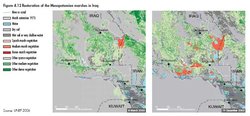 Figure 4.12 Restoration of the Mesopotamian marshes in Iraq.[13]
Figure 4.12 Restoration of the Mesopotamian marshes in Iraq.[13] Although global statistics on riparian, wetland and lake restoration are difficult to obtain, the US National River Restoration Science Synthesis database identifies over 37,000 river and stream restoration projects. It shows the number of projects increased exponentially between 1995 and 2005, and most were local initiatives not recorded in national databases. The primary listed river and stream restoration goals are: improved water quality, management of riparian zones, improved in-stream habitats, fish passage and bank stabilization [128]. Estimated costs of these projects between 1990 and 2003 were at least US$14 billion. Although global estimates of restoration efforts are not readily available, several large projects have been undertaken since 1987 in Europe, Africa and Asia. These involve the Danube River delta in Romania, Aral Sea in Central Asia and, most recently, the Mesopotamian marshes in Iraq [129] (see Figure 4.12). In the last case, more than 20 per cent of the original marshland area was re-flooded between May 2003 and March 2004, with the marshlands exhibiting a 49 per cent extension of wetland vegetation and water surface area in 2006, compared to that observed in the mid-1970s. Another example is the Waza Lagone floodplain in Cameroon, where restoration measures have produced an annual benefit of approximately US$3.1 million in fish catches and productivity, availability of surface freshwater, flood farming, wildlife and a range of plant resources [130]. But restoration is more costly than prevention, and should be a response of last resort (see [[Chapter 5 (Global Environment Outlook (GEO-4): Chapter 4)]3]).
Fish Stocks
Marine and inland fish stocks show evidence of declines from a combination of unsustainable fishing pressures, habitat degradation and global climate change. Such declines are major factors in terms of biodiversity loss. They also have serious implications for human well-being. Fish provide more than 2.6 billion people with at least 20 per cent of their average per capita animal protein intake. Fish account for 20 per cent of animal-derived protein in Low-Income Food Deficit (LIFD) countries, compared to 13 per cent in industrialized countries, with many countries where overfishing is a concern also being LIFD countries [131]. While fish consumption increased in some regions, such as southeast Asia and Western Europe, and in the United States, it declined in other regions, including sub-Saharan Africa and Eastern Europe [132]. According to FAO projections, a global shortage of fish supply is expected. Although its severity will differ among countries, the forecast is for an average increase in fish prices, in real terms, of 3 per cent by 2010 and 3.2 per cent by 2015 [133].
Marine fisheries
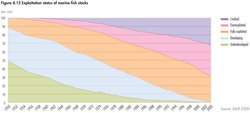 Figure 4.13 Exploitation status of marine fish stocks.[14]
Figure 4.13 Exploitation status of marine fish stocks.[14] The mid-20th century saw the rapid expansion of fishing fleets throughout the world, and an increase in the volume of fish landed. These trends continued until the 1980s, when global marine landings reached slightly over 80 million tonnes/year, following which they either stagnated [134] or began to slowly decline [135]. Aquaculture accounts for the further increase in seafood production. Output (excluding aquatic plants) grew at a rate of 9.1 per cent/year between 1987 and 2004, reaching 45 million tonnes in 2004 [136]. However, this growth has not improved food security in places where aquaculture products are primarily for export (Africa, Latin America).
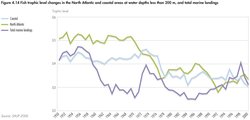 Figure 4.14 Fish trophic level changes in the North Atlantic and coastal areas at water depths less than 200 m, and total marine landings.[15]
Figure 4.14 Fish trophic level changes in the North Atlantic and coastal areas at water depths less than 200 m, and total marine landings.[15] Data on fish stocks (in terms of volume) exploited for at least 50 years within a single FAO area highlight an increase in the number of stocks either overexploited or that have crashed over the last few years (see Figure 4.13). Based on refined definitions, more than 1,400 stocks were fished. Of the 70 stocks fished in 1955, at most only one per cent had crashed, compared to nearly 20 per cent of at least 1,400 stocks fished in 2000 (240 stocks crashed). Many areas have passed their peak fish production, and are not returning to the maximum catch levels seen in the 1970s and 1980s. Another important trend is the declining trophic levels of fish captured for human consumption (see Figure 4.14), indicating a decline in top predator fish catches (marlin, tuna) and groupers [137]. These stocks are being replaced by generally less desirable, less valuable fish (mackerel and hake), higher-valued invertebrates (shrimp and squid) or higher-valued aquaculture products (salmon, tuna and invertebrates). More recently, some deep-sea fish stocks, such as the Patagonian toothfish, deepwater sharks, roundnose grenadier and orange roughy, have been severely overfished. Orange roughy stocks off New Zealand, for example, were fished to 17 per cent of their original spawning biomass within eight years [138], with recovery taking much longer. Deep sea species possess biological characteristics (long lifespan, late maturity and slow growth) that make them highly vulnerable to intensive fishing pressure (see [[Chapter 5 (Global Environment Outlook (GEO-4): Chapter 4)]4]) (see Box 5.1).
Exploitation of West Africa’s fish resources by EU, Russian and Asian fleets has increased six fold between the 1960s and 1990s. Much of the catch is exported or shipped directly to Europe, and compensation for access is often low compared to the value of the landed fish. Such agreements adversely affect fish stocks, reducing artisanal catches, affecting food security and the well-being of coastal West African communities [139]. The overexploitation of fish is forcing artisanal fishers from coastal West Africa to migrate to some of the regions that are exploiting their resources. Senegalese fishers emigrating to Spain claim the reason for leaving their homes is the lack of their traditional fisheries livelihood. Based on FAO profiles, countries in Africa with high per capita fish consumption, including Ghana, Nigeria, Angola and Benin, are now importing large quantities of fish to meet domestic demands.
A major issue is lost opportunities in jobs and hard currency revenues [140]. After processing in Europe, the end value of seafood products from these resources is estimated at about US$110.5 million, illustrating a huge disparity in value of the resources taken by EU companies, and the licence fee paid to the countries, which is only 7.5 per cent of the value of the processed products [141]. Fisheries sector employment has also decreased. In Mauritania, the number of people employed in traditional octopus fishing decreased from nearly 5,000 in 1996 to about 1,800 in 2001 because of the operation of foreign vessels [142]. In 2002, fisheries provided direct employment to about 38 million people, especially in developing regions such as Asia (87 per cent of world total) and Africa (7 per cent of world total) [143]. In developing countries, however, fisheries employment has decreased. In many industrialized countries, notably Japan and European countries, employment in fishing and associated land-based sectors has been declining for several years, in part because of lower catches [144].
Aquaculture and fish meal
 Figure 4.15 Fish meal usage in 2002 and 2012 (projected).[16]
Figure 4.15 Fish meal usage in 2002 and 2012 (projected).[16] While output from capture fisheries grew at an annual average rate of 0.76 per cent (total fish captures during 1987–2004, including freshwater), output from aquaculture (excluding aquatic plants) grew at a rate of 9.1 per cent, reaching 45 million tonnes in 2004 [145]. Aquaculture produced 71 per cent of the total growth in food fish production by weight during 1985–1997. Although the catch is stable, the use and/or demand for wild-caught fish as feed in aquaculture is changing, being more than 46 per cent of fish meal in 2002 [146], and over 70 per cent of fish oil used in aquaculture. About two-thirds of the world’s fish meal is derived from fisheries devoted entirely to its production [147].
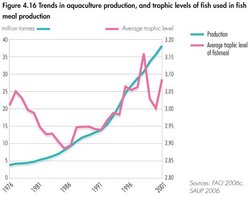 Figure 4.16 Trends in aquaculture production, and trophic levels of fish used in fish meal production.[17]
Figure 4.16 Trends in aquaculture production, and trophic levels of fish used in fish meal production.[17] Growth in aquaculture will help compensate for some shortfall in wild-caught fish, although much of the aquaculture increase has been in high-value species that meets the demands of affluent societies, and the use of fish meal from wild-caught fish for aquaculture is predicted to increase at the expense of fish meal for poultry feed (see Figure 4.15). Aquaculture growth in Africa and Latin America (for example, Chile) [148] is primarily for export, doing little to improve food security in these regions. The trophic level of species used for fish meal also is increasing (see Figure 4.16), implying that some fish species previously destined for human consumption are being diverted to fish meal. Therefore, food production and food security in other countries could be affected.
Inland water fisheries
In 2003, the estimated total catch from inland waters (excluding aquaculture) was 9 million tonnes [149]. Most inland capture fisheries based on wild stocks are overfished or are being fished at their biological limits [150]. For instance, in Lake Victoria, the Nile perch fishery decreased from a record catch of 371,526 tonnes in 1990 to 241,130 tonnes in 2002. Sturgeon catches in the countries surrounding the Caspian Sea have also decreased from about 20,000 tonnes in 1988 to less than 1,400 tonnes in 2002. In the Mekong River, there is evidence that stocks are being overfished and threatened by damming, navigation projects and habitat destruction. Several species are now endangered, with at least one, the Mekong giant catfish, close to extinction [151].
Inland fishes have been characterized as the most threatened group of vertebrates used by humans [152]. Allan and others [153] suggest that the collapse of particular inland fish stocks, even as overall fish production rises, is a biodiversity crisis more than a fisheries crisis (see [[Chapter 5 (Global Environment Outlook (GEO-4): Chapter 4)]5]). Increasing catches have been accompanied by changes in species composition, as catches of large and late maturing species have declined [154].
|
Box 4.8 Economic value of wetlands in the Middle Mun and Lower Songkhram River Basins[155] | |||
|
The Middle Mun and Lower Songkhram River Basins in Thailand provide a number of valuable services to 366 villages, with the following annual monetary values per household | |||
|
Product |
US$ |
||
|
Non-timber forest products Fish for personal consumption Commercial fish Mushroom cultivation Total |
925 1,125 27 500 2,577 | ||
According to the IUCN Red List, most of the world’s largest freshwater fish are at risk, and in a number of cases, overfishing has been a contributing factor. Recovery of fish stocks from historical overfishing is hindered or even impossible because of a host of current pressures. Now living in altered conditions, these native stocks are more vulnerable to disturbances, such as species invasions and diseases. Some inland fisheries have been enhanced through stocking programmes, the introduction of alien species, habitat engineering and habitat improvement.
At the global scale, inland fisheries represent an important source of nutrition. In the Lower Mekong River basin, for example, 40 million fishers and fish farmers are dependent on such fisheries for their livelihood (see Box). 4.8
Managing the world’s fish stocks
Fisheries management involves ecosystem maintenance and efforts to reduce overfishing. Since the Brundtland Commission report, efforts in improved fisheries management have focused on three main themes: governance, economic incentives and property rights. Global responses include reducing fishing efforts, implementing ecosystem-based management (ESBM) approaches, property rights, economic and market incentives, marine protected areas (MPAs), and enforcement of fishing regulations (see Table 4.5). International governance initiatives, including establishment of conventions and associated regional fish management bodies (RFMOs), have facilitated negotiations among countries exerting pressure on fish stocks. Their effectiveness in addressing declining stocks has been highly variable, depending on the stock and location. In northern Europe, where members of the Northeast Atlantic Fisheries Council reached consensus on reducing fishing efforts for species such as herring, the rebuilding of sustainable stocks has been effective. Where no agreement has been reached (such as for blue whiting), stocks are at risk of collapse.
The FAO’s 1988 International Plan of Action to tackle seabird by-catch has been effective in reducing seabird mortality associated with long fishing lines used to capture tuna. Other international governance initiatives (such as managing tuna in the Atlantic) have been less successful, with many stocks in danger of crashing. Well-financed RFMOs, mostly in developed countries, are generally more effective than those that are less well financed, mostly in developing countries.
Further action is needed to induce governments to increase their political commitment to reduce fishing efforts globally, and to provide funds for RFMOs to develop and implement new approaches, such as ESBM and benefit sharing models. RFMOs providing services to developing nations must receive increasing levels of catalytic funding assistance. Funding to the fisheries sector has declined since the 1990s, with far less support for improving fisheries management, compared to capital, infrastructure and technical assistance transfers.
At the national level, many countries have revised or rewritten their fisheries legislation and policies to reflect current trends, including multi-species fish management, ESBM, greater stakeholder participation in decision making and property rights. The FAO Code of Conduct for Responsible Fisheries Management provides ample guidance for incorporating these measures into legislation and policy. The Faroe Islands, for example, highly dependant on their marine fishery resources, have embraced ESBM [156]. However, many developing and developed countries are still struggling with methods for implementing ESBM for both marine and freshwater fisheries. Further development and testing of models for implementing ESBM are needed.
National and state fisheries management agencies also are implementing programmes to rebuild declining or crashed stocks through fishing effort reductions, including closures of fishing grounds and effective enforcement of regulations (such as with the Namibian hake fisheries), as well as habitat protection by MPAs. Habitat restoration, such as mangrove rehabilitation in tsunami-affected areas, and enhancement, using, for example, fish aggregation devices (FADs), is also underway in some countries. While habitat restoration can be effective in providing fish habitat, it requires significant financial and human resources. Thailand, for example, has major efforts underway with public and industry finance and support. Habitat enhancement, using structures such as artificial reefs and FADs, must be undertaken with caution. In the tropical Pacific (as in the Philippines and Indonesia) FADs used to improve pelagic catches also capture large numbers of juvenile tuna, highlighting the need to carefully consider the impacts of proposed responses [157].
Over the last 20 years, the number and sizes of MPAs have been increasing, contributing to effective fisheries management by protecting existing stocks or rebuilding depleted stocks. In the Philippines, many MPAs have been effective in rebuilding stocks, but further research is needed to assess their overall contribution to fisheries management. Despite calls under the Convention on Biological Diversity and the World Summit on Sustainable Development for more and larger MPAs, none of the targets will be met within the deadlines, given current trends. Other management responses include increased enforcement of fishing regulations through the use of technology, especially vessel monitoring systems using satellite technology. Despite the training and costs involved, this approach is effective in covering large areas of the ocean under all weather conditions, and helps in the effective and efficient deployment of enforcement officers.
The removal of market-distorting subsidies, as discussed at World Trade Organization negotiations, is being promoted to address concerns of overfishing. The EU Common Fisheries Policy has provided subsidies, resulting in increased fishing effort and distorted competition. Progress in removing subsidies has been slow, with many developing countries requesting subsidies to better manage their fisheries. There also is considerable debate among governments regarding what constitutes “good” versus “bad” subsidies. Certification schemes, such as the one used by the Marine Stewardship Council (MSC), are influencing wholesale and consumer purchases. Certification of farmed fish is an emerging issue but, since fish used for feed for many farmed species are not certified, it will be difficult for these fisheries to meet MSC criteria. Some countries have been successful in reducing fishing efforts through a range of schemes, including buying out licenses, transferring property rights, and using alternative income-generating options to compensate fishers leaving the industry. But, buyouts are expensive, and must be carefully crafted to keep fishing effort from regrowing, or shifting to other sectors within the industry. Another response, considered effective in New Zealand, but less so in Chile, where small-scale fishers have been marginalized, is the transfer of property rights to fishers in various forms, such as individual transferable quotas (as discussed under Managing water resources and ecosystems).
Challenges and Opportunities
As the Earth’s primary integrating medium, water has a wide potential to reduce poverty, increase food security, improve human health, contribute to sustainable energy sources, and strengthen ecosystem integrity and sustainability. These water-related goods-and-services represent significant opportunities for society and governments to jointly achieve the goals of sustainable development, as recognized in the Millennium Declaration and at the World Summit on Sustainable Development, in the context of the MDGs. Table 4.5, at the end of this chapter, summarizes the relative effectiveness of existing responses.
Water for poverty and hunger eradication
There is compelling evidence that a substantial increase in global food production is needed to feed growing populations, and to reduce or eliminate situations where people have insufficient food for their daily needs. This increase in production will require more water (see Figure 4.4). On a global scale, the agricultural sector uses the vast majority of [[freshwater (Freshwater biomes)] resources], and so is a logical target for economizing water use and developing methodologies for growing more food with less water (more crop per drop). Because agriculture and healthy ecosystems can be compatible goals, the major challenge is to improve irrigation for food production by increasing water and land productivity, supporting ecosystem services and building resilience, while mitigating environmental damage, especially within the context of ecosystem based IWRM approaches (see Box 4.9).
Since groundwater levels are falling, and aquifer water stores are shrinking in many highly-populated countries, much of the additional water required for agricultural production must come from dammed rivers. While acknowledging the environmental damage and socio-economic dislocation associated with construction of some dams, the building of more dams cannot be dismissed, since they can provide significant sources of water. But, more attention must be directed to understanding and balancing the environmental and socio-economic impacts associated with dam construction and operation against the benefits to be derived from them. Augmenting the resources of water-scarce regions by interbasin transfer is another established option, although proposed schemes must demonstrate the social, environmental and economic benefits to both the donating and the receiving basins.
|
Box 4.9 Integrated water resources management (IWRM)[158] |
|
As promulgated by the Global Water Partnership (GWP) in 2000, IWRM is based on three pillars: the enabling environment, institutional roles and management instruments. In 2002, the Johannesburg Plan of Implementation (adopted at the World Summit on Sustainable Development) recommended that all countries “develop integrated water resource management and water efficiency plans by 2005.” This was to include identifying actions needed to reform policies, legislation and financing networks, institutional roles and functions, and enhancing relevant management instruments to address water resource issues. The GWP (2006) subsequently surveyed 95, primarily developing, countries regarding the status of IWRM policies, laws, plans and strategies within their water resource management efforts in response to the WSSD mandate. Although the concept of an ecosystem-based approach for addressing water resources management and use issues is, like IWRM, a recent introduction to the international water arena, the survey revealed that 21 per cent of the surveyed countries had plans or strategies in place or well underway, and a further 53 per cent had initiated a process for formulating IWRM strategies. For example, South Africa has developed legislation translating IWRM into law, including provisions for its implementation. Burkina Faso defines IWRM within its national water policy. It is supporting enhanced IWRM awareness among its population, and the creation of local water committees including the private sector. The IWRM approach embraces variants such as Integrated River Basin Management (IRBM), Integrated Lake Basin Management (ILBM) and Integrated Coastal Management (ICM), all of which represent a fundamental change from single issue, command-and-control regulatory approaches for managing the water environment. A global-scale, GEF-funded ILBM project highlighting this integrated approach to lake and reservoir basin management was conducted by The World Bank and the International Lake Environment Committee. These integrated, adaptive management approaches share common principles, while also being tailored to the unique characteristics, problems and management possibilities of specific aquatic ecosystems. IWRM incorporates social dimensions, such as gender equity and empowerment of women, cultural factors and the ability to make choices. Integrated Coastal Area and River Basin Management (ICARM) is an even more comprehensive approach which links the management needs of inland freshwater basins and their downstream coastal ecosystems, while Large Marine Ecosystem initiatives represent another important step, moving from single stock to ecosystem-based fisheries management. However, it has been difficult to transform these principles and recommendations into practical actions at the international, national and local levels, due partly to a lack of experience in their application, and the challenges in overcoming institutional, scientific and other significant barriers to integration. |
While the impacts of increasing water demand for agriculture may be acceptable in countries with ample water resources, the escalating burden of water demand will become intolerable in water scarce countries. Such situations can be alleviated to some degree by water-scarce countries shifting their food production to “water-rich” ones, deploying their own limited water resources into more productive economic sectors. This would address the need for energy- and technology intensive transport of water to distant areas of demand. Although globalization in the agriculture and related food production sectors already facilitates such changes, these approaches require close cooperation between producing and receiving countries.
Better management of marine, coastal and inland waters and their associated living resources improves the integrity and productivity of these [[ecosystem]s]. Although there is little scope to expand or develop new fisheries, there is considerable opportunity to improve the management of existing fisheries and food production. Governments, industry and fishing communities can cooperate in reducing fish stock losses by making much needed changes to reduce excess fishing effort, subsidies and illegal fishing. Aquaculture currently helps to address the issue of food security, and has the potential to contribute further both by increasing fish supplies cost effectively, and by generating foreign income by exporting increased fish production, which can improve local livelihoods. But, aquaculture development to meet food security needs must include species that are not dependent on fish meal and fish oil, and that are palatable to a wide range of consumers.
Combating water-borne diseases
Although safeguarding human health ranks first among the priorities of water resources management, direct human consumption and sanitation are among the smaller uses of freshwater in terms of volume. Even though the percentage of the world’s population with access to improved water supply rose from 78 to 82 per cent between 1990 and 2000, and the percentage with access to improved sanitation rose from 51 to 61 per cent during this same period, contaminated water remains the greatest single cause of human sickness and death on a global scale. In 2002, then UN Secretary-General, Kofi Annan, pointed out that “no single measure would do more to reduce disease and save lives in the developing world than bringing safe water and sanitation to all”[159] . Improved sanitation alone could reduce related deaths by up to 60 per cent, and diarrhoeal episodes by up to 40 per cent. The UN has designated 2008 as the International Year of Sanitation, in recognition of its key role in human well-being.
Controlling many diseases that are either water-borne or closely linked to water supplies depends on the use of specific technological measures, the maintenance or restoration of aquatic ecosystems, and public education and awareness. Technological approaches, such as the construction and operation of cost-effective water treatment plants and sanitation facilities for treating human wastes, provide effective measures against water-borne diseases. Many industrial water pollutants with human health implications also are amenable to treatment with technologies that capture materials from water. These technologies can sometimes recover useful products (such as sulphur) from waste streams. Ecosystem restoration may reduce the incidence of some water-borne diseases, but it can also lead to an increase in the incidence of others. This negative aspect may be countered by improved understanding of the ecological requirements of disease vectors, and incorporating this knowledge into restoration projects. Traditional approaches, such as rainwater harvesting, can provide sources of safe drinking water, particularly in water-scarce areas or locations that experience natural disasters and other emergencies.
Global water responses and partnerships
The world’s oceans remain a huge, almost entirely untapped reserve of energy. Governments and the private sector can cooperate in exploring the energy production possibilities of the oceans, including the development of more efficient technologies for harnessing tidal and wave power as renewable sources of hydropower. The use of the oceans for large-scale carbon sequestration is another area of active investigation, though the potential impacts on the chemical composition of the oceans and its living resources remain unknown.
International water policy is increasingly emphasizing the need to improve governance as it relates to water resources management. The 2000 Ministerial Declaration of The Hague on Water Security in the 21st Century identified inadequate water governance as a main obstacle to water security for all. The 2001 International Conference on Freshwater in Bonn stressed that the essential issue was a need for stronger, better performing governance arrangements, noting that the primary responsibility for ensuring sustainable and equitable management of water resources rests with governments. Governance and water policy reforms were a core element of the Johannesburg plan for sustainable development in 2002. The Global Water Partnership (GWP) defined water governance as the exercise of economic, political and administrative authority to manage a nation’s water affairs at all levels. It consists of the mechanisms, processes and institutions through which citizens and groups define their water interests, exercise their legal rights and obligations, promote transparency and mediate their differences. The need to strengthen existing legal and institutional frameworks for water management at both the national and international levels is central to all these efforts. The acknowledgement of the centrality of integrated approaches, full implementation, and compliance and enforcement mechanisms is also key to success.
Decision-makers are increasingly adopting integrated, adaptive management approaches, such as IWRM (see Box 4.9), rather than single issue, command-and-control regulatory approaches that previously dominated water resources management efforts. An integrated approach is fundamental in achieving social and economic development goals, while working for the sustainability of aquatic ecosystems to meet the water resource needs of future generations. To be effective, such approaches must consider the linkages and interactions between hydrological entities that cross multiple “boundaries,” be they geographic, political or administrative. Ecosystem based management approaches also provide a basis for cooperation in addressing common water resources management issues, rather than allowing such issues to become potential sources of conflict between countries or regions.
There are a number of key components for achieving cooperation among water stakeholders. They include international agreements, such as the 1997 UN Watercourses Convention, the Ramsar Convention, the Convention on Biological Diversity, and the Global Programme of Action for the Protection of the Marine Environment from Landbased Activities. There is also a need to apply an ecosystem-based approach, as promulgated in the principles of IWRM, as well the Good Governance approach, developed at 1992 Rio Earth Summit and the 2002 World Summit on Sustainable Development. These approaches facilitate the sustainable and equitable management of common or shared water resources and, help achieve the goal of sustainable development in protecting freshwater and coastal sites to secure their vital ecosystem services.
More participatory regulatory approaches, such as demand management and voluntary agreements, have been introduced, due to an increasing realization of the limits of traditional regulation. These necessitate education and public involvement. Accordingly, public education curricula at all levels should vigorously address the issues of the water environment.
To enhance international cooperation in addressing the exploitation and degradation of water resources, the United Nations proclaimed 2005–2015 as the International Decade for Action, “Water for Life.” A major challenge is focusing attention on action oriented activities and policies directed to sustainable management of the quantity and quality of water resources. In 2004, the United Nations established UN-Water as its system-wide mechanism for coordinating its agencies and programmes involved in water-related issues. A complementary mechanism will facilitate integrative cross-linkages between activities coordinated under UN-Water with UN-Oceans, strengthening coordination and cooperation of UN activities related to oceans, coastal areas and Small Island Developing States.
In developing responses to the impacts of change in the water environment, national governments and the international community face a major challenge. They need to not only develop new approaches, but also to facilitate the practical, timely and cost-effective implementation of existing international and other agreements, policies and targets (see Table 4.5). Continuous monitoring and evaluation of the responses – with adjustments as necessary – are required to secure the sustainable development of the water environment for the benefit of humans, and for the maintenance of life-supporting [[ecosystem]s] over the long-term.
ContributorsCoordinating lead authors: Russell Arthurton, Sabrina Barker, Walter Rast, and Michael HuberLead authors: Jacqueline Alder, John Chilton, Erica Gaddis, Kevin Pietersen, and Christoph ZöcklerContributing authors: Abdullah Al-Droubi, Mogens Dyhr-Nielsen, Max Finlayson, Matthew Fortnam (GEO fellow), Elizabeth Kirk, Sherry Heileman, Alistair Rieu-Clark, Martin Schäfer (GEO fellow), Maria Snoussi, Lingzis Danling Tang, Rebecca Tharme, Rolando Vadas, and Greg WagnerChapter review editor: Peter AshtonChapter coordinators: Salif Diop, Patrick M’mayi, Joana Akrofi, and Winnie Gaitho (Global Environment Outlook (GEO-4): Chapter 4)
==Notes^Bromhead, D., Foster, J., Attard, R., Findlay, J., and Kalish, J. (2003). A review of the impact of fish aggregating devices (FADs) on tuna fisheries. (Global Environment Outlook (GEO-4): Chapter 4) Final Report to Fisheries Resources Research Fund. Commonwealth of Australia, Department of Agriculture, Fisheries and Forestry, Bureau of Rural Sciences, Canberra (last accessed 31 March 2007).
* ^ILEC (2005). Managing lakes and their basins for sustainable use: A report for lake basin managers and stakeholders. International Lake Environment Committee Foundation, Kusatsu, Shiga.
—GWP (2006). Setting the Change for Change. Technical Report, Global Water Partnership, Stockholm.
—WWAP (2006). The State of the Resource, World Water Development Report 2, Chapter 4. World Water Assessment Programme, United Nations Educational, Scientific and Cultural Organization, Paris (last accessed 31 March 2007).
—UNEP/GPA (2006b). Ecosystem-based management: Markers for assessing progress. UNEP-Global Programme of Action for the Protection of the Marine Environment from Land-based Activities, The Hague. * ^UN (2004). International Decade for Action, “Water for Life”, 2005-2015. UN Resolution 58/217 of 9 February 2004. United Nations General Assembly, New York, NY (last accessed 3 May 2007).

